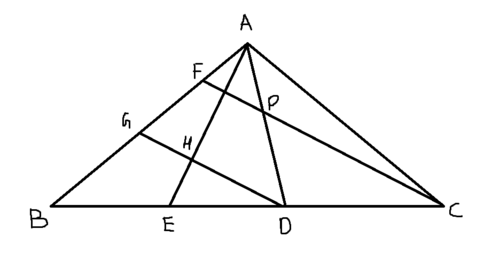Area
 In the figure BD = CD , BE= DE , AP = PD and
In the figure BD = CD , BE= DE , AP = PD and
Note - ar represents area
The answer is 0.2.
This section requires Javascript.
You are seeing this because something didn't load right. We suggest you, (a) try
refreshing the page, (b) enabling javascript if it is disabled on your browser and,
finally, (c)
loading the
non-javascript version of this page
. We're sorry about the hassle.
We know that parallel lines divide lines that cut them proportionally. That is to say, let's draw another line through A parallels to D G ∣ ∣ C F , then A F = F G because A P = D P . Let C F cuts A E at Q , then A Q = H Q .
Similarly, draw another line through E parallels to D G ∣ ∣ C F , then E H = 2 1 H Q because D E = 2 1 C D . Since △ A D E and △ A D H share the same base A E and height, then their areas A △ A D E A △ A D H = A E A H = 5 4 .
Therefore,
A △ A B C A △ A D H = A △ A D E A △ A D H × A △ A B C A △ A D E = A E A H × B C D E = 5 4 × 4 1 = 5 1 = 0 . 2 .